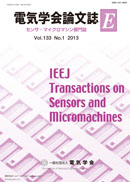All issues

Predecessor
- IEEJ Transactions on Industry Applications
- IEEJ Transactions on Electronics, Information and Systems
- IEEJ Transactions on Power and Energy
- IEEJ Transactions on Fundamentals and Materials
- The Journal of The Institute of Electrical Engineers of Japan
- The transactions of the Institute of Electrical Engineers of Japan.C
- The transactions of the Institute of Electrical Engineers of Japan.B
- The transactions of the Institute of Electrical Engineers of Japan.A
- The Journal of the Institute of Electrical Engineers of Japan
Volume 133, Issue 11
Displaying 1-10 of 10 articles from this issue
- |<
- <
- 1
- >
- >|
Review
-
Miyuki Tabata, Tatsuro Goda, Akira Matsumoto, Yuji Miyahara2013Volume 133Issue 11 Pages B314-B319
Published: November 01, 2013
Released on J-STAGE: November 01, 2013
JOURNAL FREE ACCESSThe convergence of nano-/bio- technology with biomedicine has occurred tremendously over the last few decades. In particular, next-generation biosensors offer great potential to treat serious medical problems in the fields of diagnostics, therapy, and drug delivery. Advantageously, an electrical biosensor platform composed of target-capturing element and semiconductor device as a signal transducer is compatible with a high-throughput analysis via miniaturization and integration into a small chip for decentralized bioanalytical applications. So far, we have successfully achieved potentiometric biosensing based mostly on a direct readout of innately charged biomolecules using field effect transistor (FET). Highly specific molecular recognition is available by constructing engineered biointerface on the sensor. Furthermore, the potentiometric technique provides the ability to perform label-free and real-time detection for various biomolecules. These features would help to promote personalized medicine for individual patients in the future. Here we describe fundamental aspects of electrical biosensing and review recent developments of the FET-based biotransistors.View full abstractDownload PDF (2671K)
Paper
-
Fumiaki Honda, Toshifumi Hosono, Kazutaka Sueshige, Masahisa Fujino, T ...2013Volume 133Issue 11 Pages B320-B325
Published: November 01, 2013
Released on J-STAGE: November 01, 2013
JOURNAL FREE ACCESSPZT (Pb(Zrx,Ti1-x)O3) thin film capacitors using Nano-transfer method has been developed for the fabrication technology of smaller capacitors. The adhesion strength of Pt to SiO2 was shown to be important among process factors. The adhesion force was shown to be originated from the material diffusion in the crystallization process mainly by the observation of TEM and XPS analysis. In this paper, diffusion of ingredients of PZT which is supposed to be one of the factors of the variation was investigated. It was confirmed that diffusion of Pb certainly occurs and this diffusion reinforces the adhesion strength in accordance with the Pt thickness. It is concluded that the diffusion is surely one of the factors of the variation of the adhesion strength.View full abstractDownload PDF (1250K) -
Yasushi Hashimoto, Kiyoshi Matsumoto, Isao Shimoyama2013Volume 133Issue 11 Pages 326-331
Published: November 01, 2013
Released on J-STAGE: November 01, 2013
JOURNAL FREE ACCESSThis paper proposes an ultrasonic proximal distance sensor, which uses a thermoacoustic device as a transmitter. Thermoacoustic transmitter doesn't have mechanical vibration and resonant frequency, thus it can emit a single-pulse ultrasonic, which width is under 10 µsec. Using a single-pulse ultrasonic, overlap of transmitting and receiving term is very short and it can measure very short rage such as 3 mm with excellent accuracy.View full abstractDownload PDF (856K) -
Shinji Ueki, Yuki Nishimori, Kazuhiro Miwa, Shinya Nakagawa, Hiroshi I ...2013Volume 133Issue 11 Pages 332-336
Published: November 01, 2013
Released on J-STAGE: November 01, 2013
JOURNAL FREE ACCESSIn this study, we propose a high current gain Vibrating-Body Field-Effect Transistor (Vertical VB-FET). The device has a specific structure in which drain, channel, and source electrodes of the FET are stacked. Since the current flow direction in the device is perpendicular to the wafer surface, the W/Lc (W : channel width, Lc : channel length) value is increased and improved the properties of Vertical VB-FET. In order to evaluate the dynamic properties, we derived the Lagrange's function and the dissipation function from a resistance-capacitance ladder equivalent circuit. Using these functions, we calculated the transconductance and current gain for a ring structured VB-FET. As a result, the estimated transconductance of the Vertical VB-FET was 1.81×10-2mS, whereas 1.78×10-4mS for the conventional type VB-FET with the same structure dimensions. The current gain of the vertical VB-FET also increased 15 times as large as the conventional one.View full abstractDownload PDF (2280K) -
Kinya Nakatsu, Koichi Yahata, Ryuichi Saito2013Volume 133Issue 11 Pages B337-B343
Published: November 01, 2013
Released on J-STAGE: November 01, 2013
JOURNAL FREE ACCESSThis paper describes a Direct Sensing Current Transformer (DSCTs) for the vehicle inverter system. The DSCTs was designed to measure the motor current without magnetic cores and consist of a Hall-IC and a detection wiring. The detection wiring was arranged on a power wiring of a cooling fin plate of the power module. The detection current generates the mirror current in the cooling fin plate. The mirror current generates a causes of detection error and changes the detection flux depending on the detection current frequency. The Technology of the wiring layout of Low-detection error of DSCTs in the power module is presented.View full abstractDownload PDF (1099K)
-
2013Volume 133Issue 11 Pages ES10_1-ES10_4
Published: November 01, 2013
Released on J-STAGE: November 01, 2013
JOURNAL FREE ACCESSDownload PDF (1194K)
-
[in Japanese]2013Volume 133Issue 11 Pages NL11_1
Published: November 01, 2013
Released on J-STAGE: November 01, 2013
JOURNAL FREE ACCESSDownload PDF (1184K) -
[in Japanese], [in Japanese], [in Japanese]2013Volume 133Issue 11 Pages NL11_2-NL11_10
Published: November 01, 2013
Released on J-STAGE: November 01, 2013
JOURNAL FREE ACCESSDownload PDF (626K) -
2013Volume 133Issue 11 Pages NL11_11
Published: November 01, 2013
Released on J-STAGE: November 01, 2013
JOURNAL FREE ACCESSDownload PDF (237K)
-
2013Volume 133Issue 11 Pages L11_1
Published: November 01, 2013
Released on J-STAGE: November 01, 2013
JOURNAL FREE ACCESSDownload PDF (135K)
- |<
- <
- 1
- >
- >|